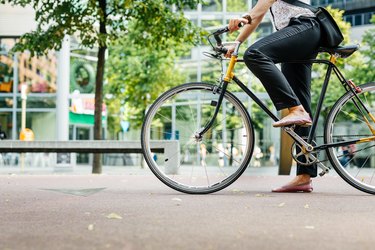
Next time you're tempted to pull into that fast-food drive-thru on your way home from work, think twice. This seemingly innocent habit might be having more of an affect on your waistline than you think.
In fact, just having fast-food options on your commute route is linked to a higher BMI, according to an August 2019 study in PLOS ONE.
Video of the Day
Video of the Day
Why is that bad news? A higher BMI (25 and above) increases your risk for certain health problems like heart disease, high blood pressure, and type 2 diabetes, according to the National Heart, Lung, and Blood Institute.
Part of the problem is the convenience and availability of quick-serve joints. "The number of fast-food restaurants located around the average commute is six times larger than around home and worksite environments," study author Adriana Dornelles, ScD, clinical assistant professor at Arizona State University, tells LIVESTRONG.com.
Since fast-food restaurants are (purposely) situated in areas with higher vehicle traffic, they're easy to notice and can understandably detour your commute — especially when you're hungry and want something quick and cheap, says Dornelles. But unfortunately, the majority offer unbalanced options, full of unhealthy levels of fat, salt and sugar.
So, how can you resist the temptation for fast food on your route to and from work? Try these eight simple strategies to help make your commute healthier.
1. Take a More Scenic Route
More than likely, you take the same streets to work every day. Try switching up your route to something off the beaten path. (Bonus if you've got a view of greenery!) Even if it takes you a bit longer, the benefits are worth it.
Not only will you bypass the same old fast-food joints, you'll also boost your mood. Indeed, commuting through natural environments can reduce stress and improve mental health, according to a December 2018 study in Environment International.
Not convinced? Yet another study, published July 2019 in Health & Place, discovered that access to green spaces can curb your unhealthy food cravings.
To explore the hidden gems in your neighborhood, try Round, a community-based GPS navigation app that helps you discover driving and walking routes in your area.
2. Pack Easy-to-Eat, Healthy Snacks
"Avoid the temptation of an unhealthy meal by carrying healthy snacks with you while you drive," says Dornelles. "It will calm your hunger until you get home."
Stow away a few easy, mess-free energy bars in your bag or glove compartment, recommends Bonnie Taub-Dix, RDN, creator of BetterThanDieting.com and author of Read It Before You Eat It: Taking You from Label to Table. Her go-to: KIND bars. They have simple, clean ingredients you can pronounce and recognize, plus they contain little sugar (around 6 grams per bar) and lots of fiber (around 7 grams). What's more, they provide a great balance of protein, carbs and healthy fats, which will help you feel satiated. And if you have a satisfied belly, you'll be less temped to pull into a drive-thru.
Read more: 19 Easy 100-Calorie Snacks That Satisfy
3. Prep Meals Ahead of Time
Hungry and unprepared? A recipe for disaster. That's why meal prep is key when it comes to avoiding unhealthy decisions on the fly. If you have a yummy meal waiting for you at home, you'll be less likely to pick up an order of fries when your belly rumbles.
Plan out your meals on Sunday, and, if you have the time, cook in bulk for the week. This way all you have to do is warm up a plate when you walk in the door after a long day at the office.
Even if you can't make dinner ahead of time, keeping your cupboard stocked with healthy ingredients is half the battle. Taub-Dix recommends always having a medley of veggies in the fridge that you can slice and dice in minutes. Better yet? Buy produce that's pre-cut and pre-washed to save time. Then toss your favorite veggies into a pan with some chicken breast and a splash of olive oil and, voila, dinner is served. For a super simple recipe, try this tasty 10-Minute Stir Fry.
4. Listen to Inspirational Podcasts
Your daily commute is the perfect opportunity to get inspired. Instead of scrolling through radio stations on autopilot, click on a motivational podcast. A little healthy encouragement may be exactly what you need to ward off fast-food cravings during your travels.
For quick, bite-sized servings of advice on clean eating habits, tune into The Nutrition Diva's Quick and Dirty Tips for Eating Well and Feeling Fabulous. Each episode is approximately 10 minutes of easy listening.
Or if you need some serious inspo, check out Hurdle. This podcast brings you real-life stories of gritty people who've overcome tough personal obstacles by getting healthy.

5. Walk or Bike to Work
Live close to your job? Why not walk or bike to work instead of driving? The 2018 study in Environment International that showed a positive connection between natural environments and mental health found that the affect was even greater for people who walked or cycled through these green spaces on their commute.
Plus, exercising on your commute is the ultimate twofer. You can sneak in a great cardio workout without setting foot in a gym. And the health benefits are huge. People who cycle to work have a lower risk of developing cardiovascular disease and cancer, per an April 2017 study in the BMJ.
Plus, all that pedaling torches a ton of calories. A 155-pound person can burn 298 calories during a half hour of cycling, according to Harvard Health Publishing.
6. Sneak in More Steps
Even if you live too far to walk or bike to work, you can still seize opportunities to get more steps into your day. If you drive, park your car farther away from the office. Commute by train or the bus? Get off one stop earlier and walk the rest of the way.
Once you're at work, skip the elevator. Hit the stairs whenever you have a chance. Stand up to take phone calls. Go for a stroll during lunch. You get the idea.
And you don't even need to aim for the prescribed 10,000 steps a day to reap health benefits. Turns out, 7,500 steps daily is the sweet spot for women, according to a 2019 study in JAMA International Medicine.
7. Do Mini Exercises in Transit
Find small ways to stay active by fitting in some fitness while you drive. How? Get creative. Work in simple stretches. You can still do torso twists and shoulder shrugs in the driver's seat.
For a little more intense muscle work, try squeezing your glutes and tightening your abs for 30 seconds at a time. Release for 10 seconds and continue, repeating the whole ride. And for a quick upper body workout, keep a hand-gripper in your car. When you're waiting for the light to change, squeeze it with your free hand and feel the burn in your forearm.
Alternatively, if you take the train or bus to work, opt to stand. You've probably heard the bad news about sitting. Too much time on your bum can increase your risk of cardiovascular disease and cancer, according to the Mayo Clinic. By standing, you can focus on balance exercises or do standing calf raises.
Read more: 10 Creative Hacks to Cut Down on Your Sitting Time
8. If You Must Eat Fast Food, Choose Wisely
If all else fails and stopping at a fast-food restaurant is inevitable, opt for healthier alternatives, says Dornelles. "Many fast-food restaurants have incorporated salads, wraps and other healthier options in their menus."
Just pull over before you chow down. "Give yourself some time to enjoy what you are eating," says Dornelles, who adds that your brain can't fully process how much you consume while you drive. And that can be bad news for your waistline. When you're distracted during a meal, you tend to eat more, according to a 2013 review in The American Journal of Clinical Nutrition.
Not to mention, eating and driving can be dangerous. In fact, a 2014 study published in Traffic Injury Prevention found that eating behind the wheel is just as distracting as texting. So, take a few minutes to nosh in the parking lot. Then hop back on the road and start planning out tomorrow's healthy dinner.
- PLOS ONE: "Impact of multiple food environments on body mass index"
- National Heart, Lung, and Blood Institute: "Assessing Your Weight and Health Risk"
- Environment International: "Active commuting through natural environments is associated with better mental health: Results from the PHENOTYPE project"
- Health & Place: "Natural environments and craving: The mediating role of negative affect"
- BMJ: "Association between active commuting and incident cardiovascular disease, cancer, and mortality: prospective cohort study"
- Harvard Health Publishing: "Calories burned in 30 minutes for people of three different weights"
- JAMA International Medicine: "Association of Step Volume and Intensity With All-Cause Mortality in Older Women"
- Mayo Clinic: "What are the risks of sitting too much?"
- The American Journal of Clinical Nutrition: "Eating attentively: a systematic review and meta-analysis of the effect of food intake memory and awareness on eating"
- Traffic Injury Prevention: "The Influence of Drinking, Texting, and Eating on Simulated Driving Performance"
Was this article helpful?
150 Characters Max
0/150
Thank you for sharing!
Thank you for your feedback!
Is this an emergency? If you are experiencing serious medical symptoms, please see the National Library of Medicine’s list of signs you need emergency medical attention or call 911.